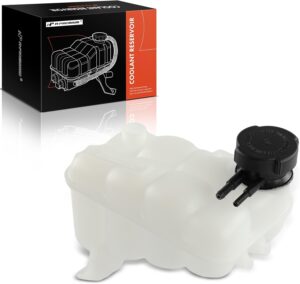
The BMW E30 is known for its classic design and performance, but as with any older vehicle, maintenance is key to keeping it in optimal condition. One of the most important components in the cooling system is the engine coolant tank. This tank is responsible for storing the coolant and ensuring the engine operates at the right temperature. Below is a detailed review of the engine coolant tank, focusing on its specifications, quality, compatibility, and performance.
Build Quality and Material
This replacement coolant tank is designed to meet or exceed OEM specifications for the BMW E30. It’s typically made from high-grade plastic that can withstand the high temperatures and pressures involved in the coolant system. A durable design helps ensure that the tank remains crack-resistant over time, preventing leaks and ensuring the system stays pressurized.
Most aftermarket tanks are manufactured using advanced plastic molding techniques that offer excellent durability. However, it’s important to select a tank with reinforced connections and proper heat resistance to match the specifications of the original BMW E30 coolant tank.
Fit and Compatibility
The coolant tank is designed specifically for the BMW E30 series, which includes the following models:
- BMW E30 318i
- BMW E30 325e
- BMW E30 325i
- BMW E30 M3
Installation is relatively straightforward, and most aftermarket coolant tanks come pre-fitted with necessary openings for coolant hoses, sensors, and pressure relief valves. The dimensions of the tank match the OEM specifications, ensuring a perfect fit without any modifications.
Performance
Once installed, this coolant tank performs as expected, maintaining the correct coolant levels in the system. The tank is pressure-tested to ensure it holds coolant without any leaks. Most models include a pressure cap, which maintains the required system pressure and helps prevent coolant boiling.
One key factor for a coolant tank’s performance is the transparency of the plastic, which allows for easy monitoring of coolant levels. High-quality tanks will not discolor quickly, ensuring that checking the coolant level remains hassle-free.
Durability
In terms of longevity, a high-quality coolant tank should last several years before requiring replacement. Factors such as UV exposure, engine heat, and coolant type can all impact the lifespan of the tank. It’s recommended to check the tank regularly for any signs of wear, such as cracking or leaks around the fittings.
Pros
- Exact Fit: Designed specifically for BMW E30 models, ensuring an easy, hassle-free installation.
- Durability: Made from heat-resistant plastic, capable of withstanding high engine temperatures.
- Affordable: A cost-effective replacement compared to OEM parts.
- Visibility: Transparent design makes it easy to check coolant levels.
Cons
- Plastic Construction: While durable, plastic tanks can eventually crack or degrade over time, especially under extreme conditions.
- Compatibility with aftermarket caps: Some models may not work well with non-OEM coolant caps, leading to pressure issues.
Specifications
| Feature | Details |
|---|---|
| Material | High-grade plastic, heat-resistant |
| OEM Compatibility | Yes, for BMW E30 models |
| Models Supported | BMW E30 318i, 325e, 325i, M3 |
| Capacity | 1.5-2 liters (varies by model) |
| Color | Transparent or semi-transparent |
| Pressure Rating | 1.2 – 1.4 bar (cap dependent) |
| Mounting | OEM-style mounting points |
| Connections | Fittings for coolant hose, sensor port, etc. |
| Dimensions | Matches OEM specification (varies slightly) |
| Weight | Approx. 0.5 kg |
| Warranty | 1-2 years (depends on manufacturer) |
Conclusion
The engine coolant tank for the BMW E30 is an essential component for maintaining the car’s cooling system. It offers a cost-effective and reliable alternative to OEM parts, providing excellent durability and an exact fit. When choosing a replacement, make sure to verify its compatibility with your specific E30 model and check for reinforced construction to ensure longevity. This is a must-have part for any E30 enthusiast looking to keep their engine running smoothly and avoid overheating issues.
FAQs
Is the replacement coolant tank for BMW E30 the same as the OEM part?
Yes, most aftermarket coolant tanks are designed to meet or exceed OEM specifications, meaning they should fit and function in the same manner as the original part. Be sure to choose a tank from a reputable manufacturer to ensure quality and durability.
Can I install the coolant tank myself?
Yes, the replacement of a coolant tank is a relatively simple task for those with basic mechanical skills. You will need to disconnect the coolant hoses, drain the old coolant (if necessary), remove the old tank, and install the new one. Ensure the system is free of air bubbles after installation by bleeding the cooling system as per the BMW E30’s procedure.
How much coolant should the tank hold?
The capacity of the coolant tank for the BMW E30 is generally around 1.5 to 2 liters. The exact capacity may vary slightly depending on the manufacturer of the tank. Always refer to your vehicle’s manual for the recommended coolant levels and specifications.
Does the coolant tank come with a cap?
Most replacement tanks do not come with a pressure cap included. It’s recommended to check whether your existing cap is in good condition or purchase a new one if necessary. The cap plays a crucial role in maintaining the proper pressure within the cooling system.
Is it safe to drive with a damaged coolant tank?
It is not recommended to drive with a damaged or leaking coolant tank. A loss of coolant can lead to engine overheating, which can cause severe damage to your engine. If you suspect a problem with your coolant tank, it’s best to stop driving and have the issue inspected or repaired.
